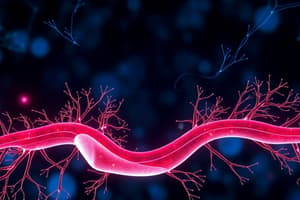Podcast
Questions and Answers
What is the main purpose of homeostasis in a living organism?
What is the main purpose of homeostasis in a living organism?
- To maintain a constant body temperature
- To respond to external stimuli
- To regulate the internal environment for normal cellular activities (correct)
- To adapt to changing environmental conditions
What is the internal environment in multicellular organisms like mammals?
What is the internal environment in multicellular organisms like mammals?
- Tissue fluid (correct)
- Blood plasma
- Cerebrospinal fluid
- Lymphatic fluid
What is the type of mechanism that achieves homeostasis in biological systems?
What is the type of mechanism that achieves homeostasis in biological systems?
- Negative feedback mechanism (correct)
- Positive feedback mechanism
- Open-loop mechanism
- Feedforward mechanism
What is the role of the receptor in a homeostatic mechanism?
What is the role of the receptor in a homeostatic mechanism?
What is the sequence of events in a homeostatic mechanism?
What is the sequence of events in a homeostatic mechanism?
What is the outcome of a negative feedback mechanism in biological systems?
What is the outcome of a negative feedback mechanism in biological systems?
What is the role of the effector in a feedback loop?
What is the role of the effector in a feedback loop?
What is the result of continuous monitoring of parameters by receptors in a negative feedback mechanism?
What is the result of continuous monitoring of parameters by receptors in a negative feedback mechanism?
What is the characteristic of thermoregulation in endothermic/homoiothermic/warm-blooded animals?
What is the characteristic of thermoregulation in endothermic/homoiothermic/warm-blooded animals?
What is the outcome of a positive feedback mechanism?
What is the outcome of a positive feedback mechanism?
What is the role of the sensor in a feedback loop?
What is the role of the sensor in a feedback loop?
What is the primary function of the kidneys?
What is the primary function of the kidneys?
What is the process of separating large molecules from small molecules in the glomerulus?
What is the process of separating large molecules from small molecules in the glomerulus?
What is the purpose of the loops of Henle in the kidney?
What is the purpose of the loops of Henle in the kidney?
What is the percentage of water in normal human urine?
What is the percentage of water in normal human urine?
What is the role of the adrenal gland in times of danger, stress, or cold?
What is the role of the adrenal gland in times of danger, stress, or cold?
What is the purpose of tubular secretion in the nephron?
What is the purpose of tubular secretion in the nephron?
What is the function of the Bowman's capsule in the nephron?
What is the function of the Bowman's capsule in the nephron?
What is the purpose of gluconeogenesis in the liver?
What is the purpose of gluconeogenesis in the liver?
What is the name of the vessel that carries deoxygenated blood from the kidney to the posterior vena cava?
What is the name of the vessel that carries deoxygenated blood from the kidney to the posterior vena cava?
What is the term for the voluntary controlled release of urine?
What is the term for the voluntary controlled release of urine?
What is the primary function of the hypothalamus in regulating body temperature?
What is the primary function of the hypothalamus in regulating body temperature?
What happens when the body detects an increase in environmental temperature?
What happens when the body detects an increase in environmental temperature?
What is the purpose of vasodilation in thermoregulation?
What is the purpose of vasodilation in thermoregulation?
What is the role of the liver in maintaining blood glucose levels?
What is the role of the liver in maintaining blood glucose levels?
What is the function of insulin in regulating blood glucose levels?
What is the function of insulin in regulating blood glucose levels?
What happens when blood glucose levels fall below normal?
What happens when blood glucose levels fall below normal?
What is the function of the islets of Langerhans in the pancreas?
What is the function of the islets of Langerhans in the pancreas?
What is the purpose of shivering in thermoregulation?
What is the purpose of shivering in thermoregulation?
What is the role of the afferent nerves in thermoregulation?
What is the role of the afferent nerves in thermoregulation?
What is the primary function of the pilo-erector muscles in thermoregulation?
What is the primary function of the pilo-erector muscles in thermoregulation?
Flashcards are hidden until you start studying




